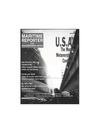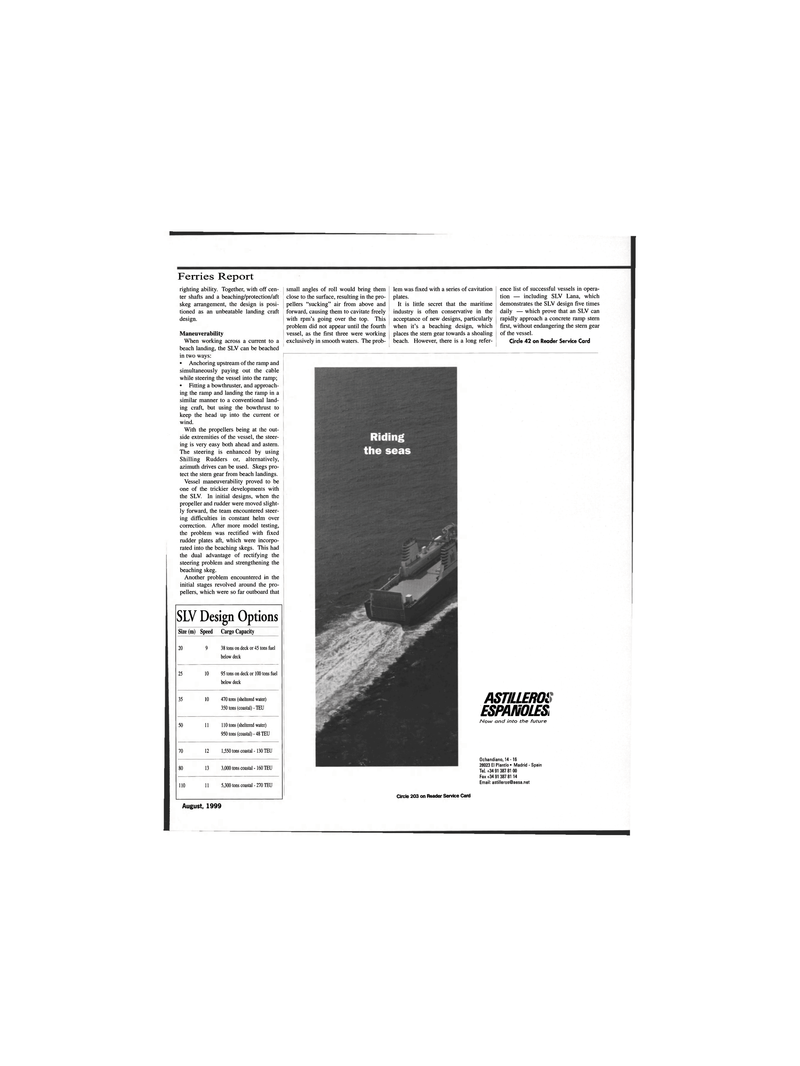
Page 37: of Maritime Reporter Magazine (August 1999)
Read this page in Pdf, Flash or Html5 edition of August 1999 Maritime Reporter Magazine
Ferries Report righting ability. Together, with off cen- ter shafts and a beaching/protection/aft skeg arrangement, the design is posi- tioned as an unbeatable landing craft design.
Maneuverability
When working across a current to a beach landing, the SLV can be beached in two ways: • Anchoring upstream of the ramp and simultaneously paying out the cable while steering the vessel into the ramp; • Fitting a bowthruster, and approach- ing the ramp and landing the ramp in a similar manner to a conventional land- ing craft, but using the bowthrust to keep the head up into the current or wind.
With the propellers being at the out- side extremities of the vessel, the steer- ing is very easy both ahead and astern.
The steering is enhanced by using
Shilling Rudders or, alternatively, azimuth drives can be used. Skegs pro- tect the stern gear from beach landings.
Vessel maneuverability proved to be one of the trickier developments with the SLV. In initial designs, when the propeller and rudder were moved slight- ly forward, the team encountered steer- ing difficulties in constant helm over correction. After more model testing, the problem was rectified with fixed rudder plates aft, which were incorpo- rated into the beaching skegs. This had the dual advantage of rectifying the steering problem and strengthening the beaching skeg.
Another problem encountered in the initial stages revolved around the pro- pellers, which were so far outboard that
SLV Design Options
Size (m) Speed Cargo Capacity 20 9 38 tons on deck or 45 tons fuel below deck 25 10 95 tons on deck or 100 tons fuel below deck 35 10 470 tons (sheltered water) 350 tons (coastal) - TEU 50 11 110 tons (sheltered water) 950 tons (coastal)-48 TEU 70 12 1,550 tons coastal -130 TEU 80 13 3,000 tons coastal-160 TEU 110 11 5,300 tons coastal-270 TEU
August, 1999 small angles of roll would bring them close to the surface, resulting in the pro- pellers "sucking" air from above and forward, causing them to cavitate freely with rpm's going over the top. This problem did not appear until the fourth vessel, as the first three were working exclusively in smooth waters. The prob- lem was fixed with a series of cavitation plates.
It is little secret that the maritime industry is often conservative in the acceptance of new designs, particularly when it's a beaching design, which places the stern gear towards a shoaling beach. However, there is a long refer- ence list of successful vessels in opera- tion — including SLV Lana, which demonstrates the SLV design five times daily — which prove that an SLV can rapidly approach a concrete ramp stern first, without endangering the stern gear of the vessel.
Circle 42 on Reader Service Card
AST/LLEROS ESPANOLES
Now and into the future
Ochandiano, 14-16 28023 El Plantio • Madrid - Spain
Tel. +34 91 387 81 00
Fax+34 91 387 81 14
Email: [email protected]
Circle 203 on Reader Service Card

 36
36

 38
38
